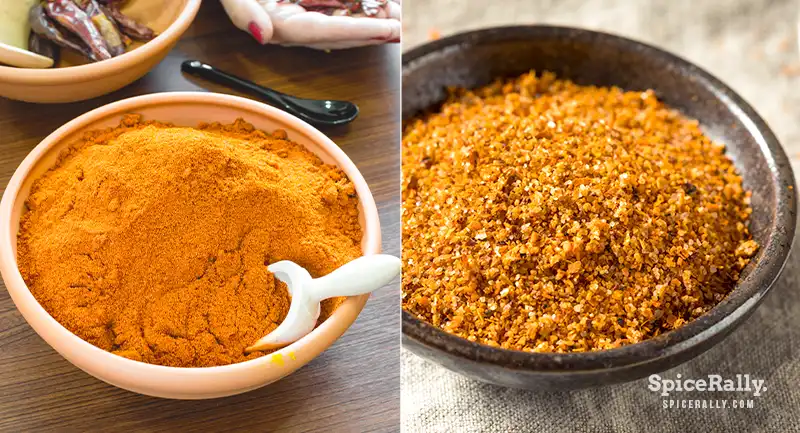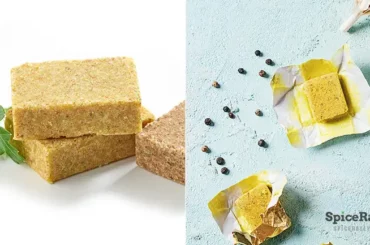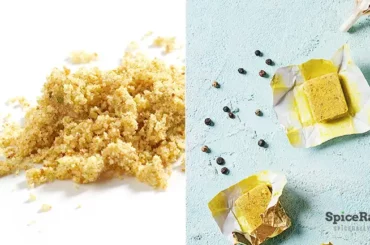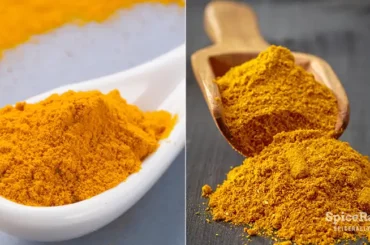Spicy food lovers are habitually experimental with their dishes, so they tend to try different flavorings. Thus, we thought of explaining to you about chili powder vs chili seasoning, which may often confuse you.
Chili powder is typically a blend of ground red chilies (the base), a few other ground spices/ herbs like garlic, cumin, and oregano, along with salt. But chili seasoning contains about 8 different ingredients (spices and herbs), and most premade ones include a thickening agent. Most chili seasoning options are focused on flavoring chili recipes, while chili powder is considered more versatile.
We hope to address every possible confusion you have about chili powder and chili seasoning. Keep reading!

The differences between Chili Powder & Chili Seasoning- SpiceRally Drill Down
| Chili Powder | Chili Seasoning | |
|---|---|---|
| Base ingredient | Chili peppers (mostly ground cayenne pepper) | Chili peppers |
| Other ingredients | – Ground cumin – Garlic powder – Dried oregano – Onion powder (occasional) – Salt Store-bought options include: – Silicon dioxide – Other flavors, color additives, – and preservatives | – Ground cumin – Garlic powder – Onion powder – Paprika – Black pepper – Red chili flakes – Dried Oregano – Salt Some homemade and store-bought options might contain: – Rice flour – Potato starch – Corn starch – Wheat flour – Corn Maltodextrin – Ground cinnamon – Cocoa powder – Dried basil – Sugar – Other additives and preservatives |
| Base flavor | Spicy and savory | Spicy and savory |
| Flavor profile | Less intense and flavorful than chili seasoning. Dark chili powder options could possess a more earthy, smoky undertone. | It can be more flavorful and deep in flavor than chili powder with spicier, more savory, slightly sweet hints. |
| Color | Usually, dark red or deep brown in color, but dark chili powder has a more deep, reddish-brown hue. | Typically has a color ranging from light to dark reddish brown. |
| Texture | Dry mixture. Has a more powdery consistency than chili seasoning. | Dry mixture. But this could sometimes have a coarser texture than chili powder due to the addition of various herbs and red chili flakes. |
| Mode of usage in cooking | As an ingredient | As an ingredient |
| Usages in cooking | – To spice up curries, hearty stews, chili, soups, and broths. – Can be added to meat, fish, seafood, tofu, and vegetable dishes. – Can be directly incorporated into wet rubs and marinades or used as a dry rub. – To sprinkle over roasted nuts, popcorn, or fries. – Can be added to jazz up rice and noodle dishes. | – Mainly used in various chili recipes – Can be added to ground meat mixtures when making burger patties, sausages, meatballs, etc. – Adds a spicy kick to popcorn, grilled corn, roasted/ baked potatoes, etc. – Sprinkle in to spice up mac and cheese and creamy dips or sauces. – Thickener-free options can be great rubs when roasting meat, fish, or vegetables. |
| Origin | Western cuisine | Western cuisine |
| Mostly used cuisines | West Asian, Latin American, and East European cuisines. | Tex-Mex, Mexican, and South American cuisines |
| Availability | – Widely available in local stores, supermarkets, and online shopping sites. – Most often sold in containers/ packets of different quantities. | – Readily available with online vendors, local groceries, or supermarkets. – Often comes as chili seasoning packets but is also sold in containers. |
| Storage | – Once opened, store in a tightly-sealed glass container in a dry, cool, dark place. – Can be stored in your spice cupboard with the rest of your dry spices/ herbs/ mixtures. | – Once opened, store in a tightly-sealed glass container in a dry, cool, dark place. – Can be stored in your spice cupboard with the rest of your dry spices/ herbs/ mixtures. |
| Category of food | Spice blend/ seasoning | Spice blend/ seasoning |
More Insights Into The Difference Between Chili Powder And Chili Seasoning
As you see, even though chili powder and chili seasoning possess a similar appearance, they aren’t the same in terms of their content and flavor. In fact, chili seasoning tends to be much more intense, with a deep flavor and texture than chili powder.
Above all, most chili seasoning packets and containers you often buy from the store typically include some thickening agent like corn starch, rice flour, or enriched wheat flour. And we can find wheat flour in some homemade chili seasoning recipes as well.
The reason for adding a thickening agent is mainly because chili seasoning is produced to add depth to your chili recipes. And therefore, chili seasoning could not be a favorable addition to certain recipes that calls for a lighter texture.
On the contrary, chili powder does not typically contain thickening agents and does not virtually affect the consistency of a particular dish. Consequently, chili powder can be considered a winner in terms of versatility. And it could be a great meat/ fish/ seafood/ vegetable rub or incorporated into wet rubs and marinades without altering the texture and could be adjusted accordingly.
Can Chili Powder Be Used In Place Of Chili Seasoning And Vice Versa?
Chili powder can be a possible alternative when you don’t have chili seasoning around. But, as mentioned previously, you will not get the thickness of chili powder, and you will usually get it from your chili seasoning.
However, things work equally, and vice versa, since chili seasoning can make your recipes unnecessarily thick or change the texture if you use it instead of chili powder. So, we recommend using these two ingredients interchangeably if only you feel comfortable with the mouthfeel change of texture and flavor.



